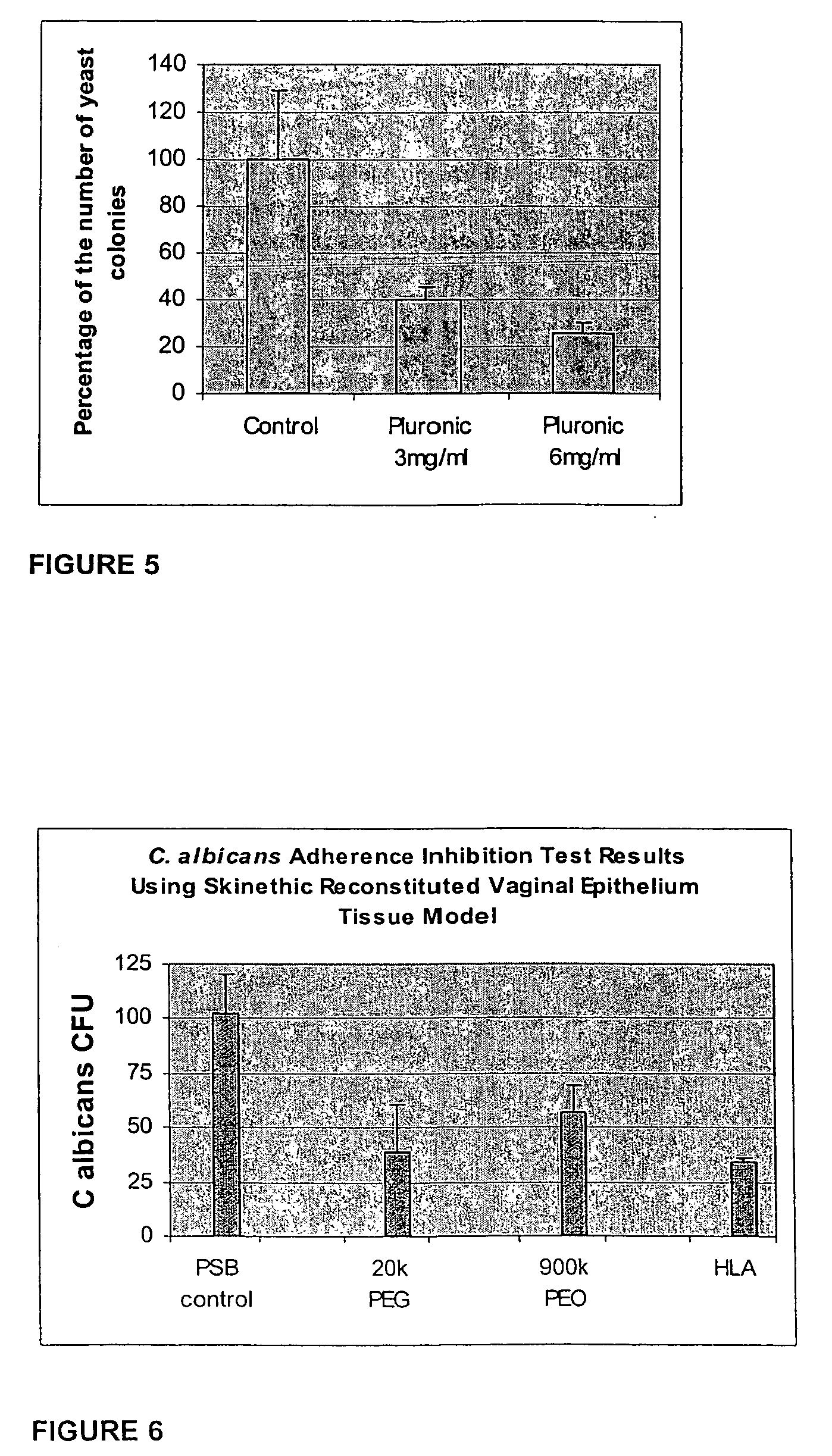Urogenital infection inhibition
a technology of urogenital infection and inhibition, applied in the direction of bandages, synthetic polymeric active ingredients, drug compositions, etc., can solve the problems of increasing the susceptibility to vaginal infection, and reducing the adherence rate of yeas
- Summary
- Abstract
- Description
- Claims
- Application Information
AI Technical Summary
Benefits of technology
Problems solved by technology
Method used
Image
Examples
experiment 1
[0045] Testing of 20 k PEG and 900 k PEO polymers for their ability to inhibit C. albicans cell adherence using monolayer vaginal epithelium cell model was performed using the following materials and method.
[0046] PEG 20 k (from Sigma-Aldrich, Cat #:81300)
[0047] PEO 900 k (from Sigma-Aldrich, Cat #:18,945-6)
[0048] Hyaluronic acid (HLA) potassium salt (from Sigma-Aldrich Cat# No. H-1751) (positive control) which has been shown to inhibit pathogen adherence to epithelium cells as shown in commonly assigned U.S. patent application Ser. No. 10 / 401,522.
[0049]C. albicans: ATCC 10231
[0050] A431 epithelial cells, ATCC CRL-1555
[0051] 5 mg / ml polymer solutions were prepared using sterilized 1×PBS solution. A monolayer of A431 epithelial cells, ATCC CRL-1555, was grown on a 24-well tissue culture plate until confluent. 1.0 ml of PBS control or polymer solution samples was added onto each epithelial tissue and incubated at 37° C. for 30 minutes. We then removed 0.5 ml of the liquid soluti...
experiment 2
[0053] This experiment used PLURONIC® F127 as the example amphiphilic block copolymer and C. albicans as the example pathogen to demonstrate the efficacy of amphiphilic block copolymer. The following procedure was used. [0054] 1. Cultured Candida albicans (yeast), ATCC 10231, in trypticase soy broth (TSB). [0055] 2. Cultured a monolayer of A431 cells, ATCC CRL-1555 on cover slips in a 24-well tissue culture plate until confluent. [0056] 3. Dissolve PLURONIC® (PLURONIC® 127 from BASF) in PBS solution to get 3 mg / ml solution. [0057] 4. Added 1.0 ml of PBS or PLURONIC®) solutions into each well with confluent A431 cells. [0058] 5. Incubated for 30 minutes at 37° C. [0059] 6. Removed 0.5 ml of the solution. [0060] 7. Added 0.5 ml of the yeast TSB suspension (at a concentration of 5×105 cfu / ml). [0061] 8. After two hours of incubation, removed the supernatant from the wells and the wells were rinsed thoroughly with PBS to remove all non-bound yeast. [0062] 9. Transferred the cover slips...
experiment 3
[0067] Testing 20 k PEG and 900 k PEO for their ability to inhibit C. albicans cell adherence using commercial SKINETHIC® reconstituted vaginal epithelium tissue, available from SkinEthic Laboratories (45, rue Saint-Philippe, 06000 Nice, France).
[0068] 5 mg / ml 20 k PEG and 900 k PEO polymer solutions were prepared using sterilized 1×PBS solution.
[0069] A reconstituted vaginal epithelial tissue model from SKINETHIC® was used, which consists of airlifted, living, multi-layered epithelial tissue produced in polycarbonate inserts in a serum-free and chemically defined medium, featuring normal ultra-structure and functionality equivalent to the epithelia of humans in vivo.
[0070] Prior to testing, each 0.5 cm2 SKINETHIC® human epithelial tissue was moved into a 24-well plate with 0.5 ml fresh SKINETHIC®) Maintenance (at room temperature) and added 0.5 ml of PBS or polymer solution sample on top of the epithelial tissue, and incubated for 30 minutes at 37° C.
[0071] Then 0.5 ml of the y...
PUM
| Property | Measurement | Unit |
|---|---|---|
| Percent by mass | aaaaa | aaaaa |
| Percent by mass | aaaaa | aaaaa |
| Percent by mass | aaaaa | aaaaa |
Abstract
Description
Claims
Application Information
 Login to View More
Login to View More - R&D
- Intellectual Property
- Life Sciences
- Materials
- Tech Scout
- Unparalleled Data Quality
- Higher Quality Content
- 60% Fewer Hallucinations
Browse by: Latest US Patents, China's latest patents, Technical Efficacy Thesaurus, Application Domain, Technology Topic, Popular Technical Reports.
© 2025 PatSnap. All rights reserved.Legal|Privacy policy|Modern Slavery Act Transparency Statement|Sitemap|About US| Contact US: help@patsnap.com



